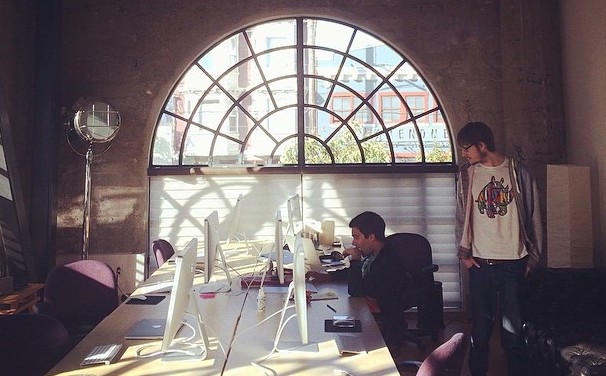What if you swiped through Instagram rather than scrolling? What if posts were anonymous until you commented and the author replied? What if you’re already too old to know what kids like?
Swipe raises these questions, and it’s that last one that may have prompted top early-stage firms Sherpa Ventures, First Round Capital, Lowercase Capital and Binary Capital to invest $6.5 million into the app at a $50 million pre valuation.
 Swipe’s iOS app (Android coming soon) is deceptively simple, until you hear the twist. Take a photo or video, write on top of it if you want, and share it with all your friends. When they open the app, they’ll see your photo full screen. Swipe left to delete it, swipe right to like it, and swipe up to reply to the author.
Swipe’s iOS app (Android coming soon) is deceptively simple, until you hear the twist. Take a photo or video, write on top of it if you want, and share it with all your friends. When they open the app, they’ll see your photo full screen. Swipe left to delete it, swipe right to like it, and swipe up to reply to the author.
The catch is you don’t know who the author is. Only if you reply and they respond will their identity be revealed. It’s a bit like Facebook’s attempt at ephemeral sharing Slingshot, except it’s the names, not the content that you have to unlock with a reply.
Swipe’s mechanics makes it:
- Super quick to share to all your friends and know they’ll see your posts
- Casual and lighthearted because you don’t have to put your name on anything
- Flirty and mysterious since you can entice people anonymously then reveal your identity in private
“It’s a really good version of ‘Go Fish’ where there is zero social cost to fishing,” says investor Jonathan Teo of Binary Capital. You can post something provocative or alluring, but only fess up to being the author if you want. And if no one takes the bait, the post will just disappear.
If you’re looking for some cut-and-dried “utility,” you’re using the wrong app. But judging by the success of apps like Yik Yak with younger audiences, quick and fun can be enough.
Throwing Spaghetti At The App Store
Developing the app was certainly fast. Co-founders Marwan Roushdy and Addison Hardy briefly worked for Connect.com after moving to San Francisco the same week from Egypt and North Carolina, respectively. They set off together to build a furniture rental app called Fonzy.
“We shipped out a Jackson Pollock style painting (that I painted) to 500 startups and a disarmed world war two bomb shell to the YC office. I think YC still has that bomb in their lobby,” says Roushdy.

Roushdy (Left) and Hardy (right) toil on their app
But Fonzy was a flop. Their next attempt, Tag, raised money and hired a team but went nowhere after eight months. Sick of pouring their hearts into failures, they took the app studio approach, building something new every few months until something stuck.
“We were very lucky that our second attempt took off. We built the very first version of swipe over a weekend, took it to a party, and it instantly started to spread from the very first day.”
Succeeding with a social app has been likened capturing lightning in a bottle, and early numbers suggest Swipe might have done it. In the last 30 days, the company says it added a half million users and seen 100 million swipes, and the app’s only been out for 2.5 months. “Almost all of our users are middle and high school kids and we are starting to spread to a lot of colleges,” Roushdy tells me.
And not just any kids. Popular kids. Swipe uses an ingenious invite system where occasionally rather than a photo, you’ll see a card that says “[A friend’s name] has 52 friends on Swipe but has not joined yet. Do you want to send an invite? :) ” Swiping right sends an invitation via SMS. “The way our invite system works, it goes to the most connected people first. So all the cool kids are on it,” Roushdy tells me.
Ephemerality + Anonymity
Will Swipe be able to build on this buzz? “The biggest risk for any new social product is when people get bored of it faster than the speed at which it reaches critical mass,” Roushdy admits.
I’ll confess I didn’t get much out of Swipe. The photos were a little too careless and I’ve reached the age where I’m comfortable having my name attached to what I create. It’s easy for someone to spam the feed anonymously, filling it with boring photos. Swipe seems so flimsy I might churn out at any moment. But perhaps it’s just that lightness that kids love.

Swipe has plenty of runway to find out, as it raised a $1.7 million seed round at a $10 million valuation in November 2014, and now has $6.5 million more. With a team of just the two founders and two employees, that cash should last a long time in case they need to pivot again. Shervin Pishevar of SherpaVentures which led the round says, “SherpaVentures believes in Swipe and the founders and that they are defining a new social mobile experience that has tapped into a level of viral growth that is rare to find.”
Swipe embraces the new rules of photography. You always have your phone. There’s no limit to how many photos you can take. And you might not want every shot to represent you forever.
Snapchat’s ephemerality was the first ingredient of off-the-cuff sharing, but it’s still based largely around ego and showing how interesting or funny you are. Swipe hopes optional anonymity will be a second reason to shoot from the hip.
